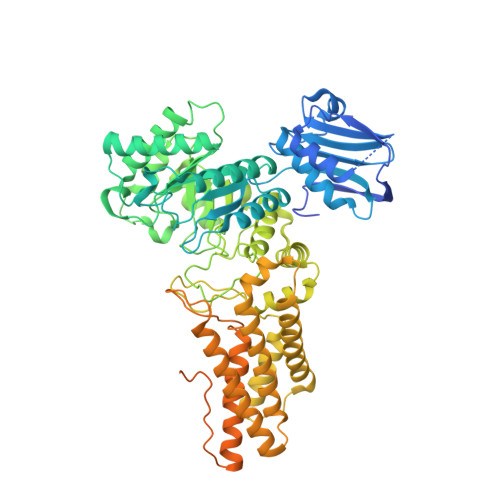Elevation of Global O-Glcnac Levels in 3T3-L1 Adipocytes by Selective Inhibition of O-Glcnacase Does not Induce Insulin Resistance
Macauley, M.S., Bubb, A., Martinez-Fleites, C., Davies, G.J., Vocadlo, D.J.(2008) J Biological Chem 283: 34687
- PubMed: 18842583
- DOI: https://doi.org/10.1074/jbc.M804525200
- Primary Citation of Related Structures:
2VVS - PubMed Abstract:
The O-GlcNAc post-translational modification is considered to act as a sensor of nutrient flux through the hexosamine biosynthetic pathway. A cornerstone of this hypothesis is that global elevation of protein O-GlcNAc levels, typically induced with the non-selective O-GlcNAcase inhibitor PUGNAc (O-(2-acetamido-2-deoxy-D-glycopyranosylidene) amino-N-phenylcarbamate), causes insulin resistance in adipocytes. Here we address the potential link between elevated O-GlcNAc and insulin resistance by using a potent and selective inhibitor of O-GlcNAcase (NButGT (1,2-dideoxy-2'-propyl-alpha-D-glucopyranoso-[2,1-D]-Delta 2'-thiazoline), 1200-fold selectivity). A comparison of the structures of a bacterial homologue of O-GlcNAcase in complex with PUGNAc or NButGT reveals that these inhibitors bind to the same region of the active site, underscoring the competitive nature of their inhibition of O-GlcNAcase and the molecular basis of selectivity. Treating 3T3-L1 adipocytes with NButGT induces rapid increases in global O-GlcNAc levels, but strikingly, NButGT treatment does not replicate the insulin desensitizing effects of the non-selective O-GlcNAcase inhibitor PUGNAc. Consistent with these observations, NButGT also does not recapitulate the impaired insulin-mediated phosphorylation of Akt that is induced by treatment with PUGNAc. Collectively, these results suggest that increases in global levels of O-GlcNAc-modified proteins of cultured adipocytes do not, on their own, cause insulin resistance.
- Department of Chemistry, Simon Fraser University, Burnaby, British Columbia V5A 1S6, Canada.
Organizational Affiliation:

















